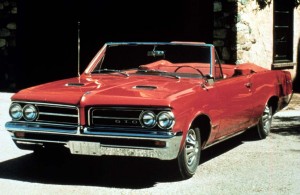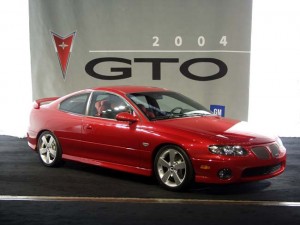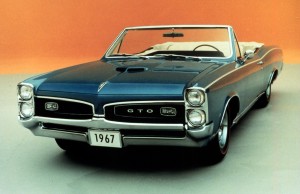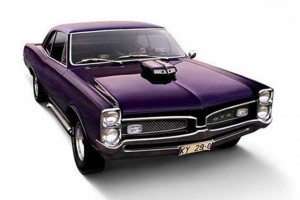
Pontiac initially started out by stuffing a big V-8 under the hood of its little LeMans to create the new GTO.
News about the GM ignition switch recall debacle is a stark contrast to a time when it was the unrivaled automotive leader that built cars people wanted – no, desired.
A reminder of those heady days recently occurred at the Automobile Driving Museum in El Segundo, California in celebration of the 50th anniversary of a GM car that turned heads, tore up the streets and became an icon – the 1964 Pontiac GTO.
It came to market within months of another legendary model also celebrating its Golden Anniversary, the Ford Mustang. But while that “pony car” is still going strong, the GTO – or “goat,” as it was known to fans — has faded into memory, despite a failed attempt to revive the nameplate on one of the last products Pontiac produced before it, too, was tossed onto the automotive rust heap following GM’s 2009 bankruptcy.
But there was a time when the GTO tapped into the needs and desires of young people who were just reaching driving age, becoming an icon of the ‘60s and ‘70s. Ironically, it almost didn’t get made.
“There was a new group of buyers coming into the market. Kids wanted personal mobility and some high performance mobility. Young people were the driving force,” said Jim Wangers, former PR and advertising executive for Pontiac.
They saw these kids out on the streets racing their cars down Detroit’s main drag, Woodward Avenue. It was a laboratory for the marketing guys and for some of DeLorean’s engineers who’d join in the fun.
(Muscle cars rule at the 2014 NY Auto Show. Click Here to check them out.)
Wangers was addressing an overflow crowd who’d come to the museum. He shared stories about working with two executives at Pontiac, John DeLorean and his boss, Semon “Bunkie” Knudsen and how they struggled to figure what would appeal to the greatest market segment ever to hit this country, “which was the group we now call the Baby Boomers.”
They had a problem. Pontiac wasn’t a car a kid would want. Knudsen’s son told him that his cars “sucked.”
The kids thought they were “grandma’s” cars, laughed Wangers, an image DeLorean and Knudsen set out to change when they launched an assault on Florida’s Daytona Speed Week and Race in February of 1957. Bunkie’s friends at the Bloomfield Hills Country Club laughed when they heard he was going racing. They said, “in what?”
But with the help of Daytona regulars like Cotton Owens, who would become an icon of NASCAR, the Pontiac team turned the scorn to cheers, one of their new race cars clocking in at 141.2 miles per hour – the fastest time ever for an American car in its class.
Lap after lap, they showed they could compete, Owens flying across the finish line to capture Pontiac’s first win. They kept racking up victories, the resulting publicity, combined with a new look, giving Pontiac the boost it needed. It jumped from sixth to third place in sales by 1962, putting this once-moribund carmaker just behind Chevrolet and Ford.
(Ford reveals special 50th anniversary Mustang. Click Here for a closer look.)
But success became a problem for GM. While hard to imagine today, in the early ‘60s it had a 55% market share and was getting dangerously close to 60%, a point at which, the federal government signaled, it would push to break up the automaker like it had Standard Oil years before. GM knew the Feds meant business. Panic ensued.
GM issued a corporate edict on January 26, 1963 that put a stop to any support for racing and told the team at Pontiac, “stop attracting young people,” recalled Wangers. That didn’t sit well with the maverick DeLorean, who was aware that crosstown rival Ford was developing a sporty car – the Mustang – that would attract the young buyers he coveted.
But he was stumped – until Russ Gee, a Pontiac engineer for engine development and Bill Collins, the suspension engineer, came up with an idea. Working on a prototype for the compact 1964 LeMans, “Gee says, to John ‘Do you see the motor mount? They’re the same on all our cars. Would take me 20 minutes to switch out the 326 cubic inch engine and put a 389 cubic inch (V-8) in here,’” said Wangers.
(The “pony car” that almost wasn’t. Click Here to find out the unlikely story of how the Ford Mustang came into being.)
Of course, DeLorean knew that putting a larger engine in the lightweight car would turn it into a screamer. He told Gee to go ahead and they rolled it out for a lap around the Proving Ground’s banked track. It was a rocket ship on wheels.

The 2004 GTO had muscle, but none of the original "Goat's" panache - and lasted just a couple years.
“In other words, take the biggest engine and stuff it into the smallest chassis. Which is a trick the hot rod community had been doing for years. Well, Pontiac decided to do it as a manufacturer,” said Wangers.
DeLorean vowed to get this into production. He’d add a few more modifications that would make the kids salivate. He also figured out a way around the corporate ban. He wouldn’t tell them. File this under it’s always easier to beg forgiveness than ask for permission.
There was a loophole in the GM system. As long as a car wasn’t a new model and if you’re just adding options or features then a division didn’t have to run it by the all-powerful corporate committee that was supposed to enforce the ban, the Engineering Policy Group (EPG). DeLorean swore his team to secrecy and they got to work building it and testing it.
Their skunk works was almost unmasked when Gee was running prototypes pretty hard at the Proving Ground. “He passes some guys from Olds(mobile) and realizes that he may have blown his cover. He pulls off and heads for the Pontiac garage,” said Wangers. “The Olds guys come knocking and ask, ‘what are you running?’ Gee says, ‘we’re just testing some exhaust stuff.’ They’re not really buying it but he fends them off.”
They were able to build 5,000 without any of the other divisions or upper management knowing. DeLorean was pleased with what they’d done and christened it the GTO. Which stands for gran turismo omologato or homologated. In Europe this is a high-speed road car built with parts manufactured by a carmaker but not necessarily intended for that model.
It also a name Ferrari was using. DeLorean was more than willing to tweak Enzo Ferrari’s nose. DeLorean enjoyed antagonizing Ferrari so much that Wangers rigged a showdown with Ferrari for Car and Driver magazine, where Pontiac’s GTO bested the Italian supercar in a 0-100 mph test. They neglected to tell David E. Davis, the Car and Driver writer, that they’d replaced the 389 engine with a 427 – just an oversight – can happen to anyone.
As it gets closer to the new model introductions – where dealers will be ordering for the Fall, DeLorean starts telling key dealers that they were going to be part of a “test.” Many of these dealers had a performance guy who’d test the cars and they were amazed. In less than 30 days they had orders for 15,000 GTOs – or, more precisely, a LeMans with the GTO option.
But dealers from the other GM divisions started hearing about this test program and began calling upper management. They wanted one too. Knudsen and DeLorean were summoned to corporate headquarters. Pontiac was ordered not to do anything with the car until management could hear about it.
“DeLorean’s worried – he’s got 15,000 orders already,” said Wangers, but somehow they convinced management to put the GTO into production. The other divisions would get their own muscle cars, but it would take them several years to catch up.
“The car was at the right place at the right time – the GTO. And of course, when it hit the marketplace it was an overnight smash,” said Wangers.
The kids loved it and the muscle car era was born. It even inspired a song, Ronnie & The Daytonas’ Top 40 anthem, “Little GTO.”
“These were cars that you could plant your foot in and get thrust back in the seat and have some fun,” said Wangers.
The”Goat” remained a staple of the muscle car market for the next decade, fending off challengers like the Mustang and the Dodge Challenger. But it ultimately succumbed to the first Mideast oil crisis, GM killing the car in 1974.
Three decades later, the Pontiac division floundering, the GTO nameplate was brought back to life – GM trying to recreate the original concept by stuffing a big V-8 under the hood of an Australian import, a left-hand-drive version of the Holden Commodore. But the new model’s performance couldn’t overcome its bland looks and it lasted until just 2006. Three years later, Pontiac itself was terminated, one of four GM brands killed off as part of its post-bankruptcy strategy.
Today, GM’s challenge is to find a way to tap into the needs and desires of a different generation. Maybe the company needs another team that’s not afraid to take a risk or two and build cars that will make people want to sing its praises.
(You can see more of Michael Rose’s work at the King Rose Archives.)



Lead with the ignition switch “debacle.” Really? And based on sales, GM apparently still makes cars that people desire.
I worked for Pontiac Motor Division in Pontiac, MI during those times in IT. Although I didn’t have a 64 (just bought a 64 Mustang), but a 65 and a 66 and both were Royalized at Royal Pontiac in Royal Oak,MI which upgraded them from 389s to 421SDs. Which the article says 427 (never made by Pontiac) should be 421 (maybe even 421SD).
Once again, another false story about the end of muscle cars. The first middle east oil crisis (which didn’t take place till October 1973!)did NOT kill the GTO or any of the muscle cars. Insurance surcharges and the dawn of the personal luxury coupe did. Not even pollution standards are to blame (again, they didn’t kick in till 1974, and catalytic converters came in 75…although Chrysler managed to go without them till 1977.
The GTO’s death is particularly maddening because in the end, it was a new Pontiac General Manager Jim McDonald then Martin Caserio who not only turned the new GTO already done into the Grand Am, but then kept the already done and certified 455SD out of the car……that’s right, there was going to be a continued GTO in 1973, 1974, 1975, 1976, and 1977!
The Ventura GTO (which happened to be the last one made till 2004) was an attempt to get into what was starting to become a new musclecar era. Pony cars were all but dead, muscle cars weren’t selling anywhere near what they were due to high insurance, and a new level of performance cars were growing: Dart and Duster 360s, Nova SS, Maverick Grabbers, & Hornet SSTs seemed to be where performance was heading. Only Aspen R/Ts and Volare Roadrunners reached a level of success and longevity.
But no, government mandates, oil crisis, or even fuel economy and emissions did NOT kill performance and muscle cars. Insurance rates and baby boomers growing into their 30s and having families is what killed them well before the commonly believed culprits.
The insurance rates certainly became outrageous, that’s for sure. That’s how much power industry monopolies wield and they are usually bad for society.